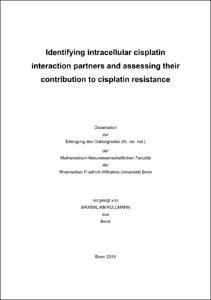Identifying intracellular cisplatin interaction partners and assessing their contribution to cisplatin resistance

Identifying intracellular cisplatin interaction partners and assessing their contribution to cisplatin resistance

| dc.contributor.advisor | Jaehde, Ulrich | |
| dc.contributor.author | Kullmann, Maximilian | |
| dc.date.accessioned | 2020-04-22T22:04:07Z | |
| dc.date.available | 2020-04-22T22:04:07Z | |
| dc.date.issued | 24.10.2016 | |
| dc.identifier.uri | https://hdl.handle.net/20.500.11811/6875 | |
| dc.description.abstract | Intracellular binding of cisplatin to non-DNA partners, such as proteins, has received increasing attention as an additional mode of action as well as a mechanism of resistance. In this project three cisplatin-interacting proteins, two members of the protein disulfide isomerase family (PDIA1 and PDIA3) and 78 kDA glucose-regulated protein (GRP78), have been identified by means of the fluorescent cisplatin analogue CFDA-cisplatin. These proteins have been investigated regarding their contribution to acquired cisplatin resistance using a sensitive and cisplatin-resistant ovarian cancer cell line pair (A2780/A2780cis). Cisplatin cytotoxicity after knockdown of PDIA1, PDIA3, or GRP78 was assessed using the MTT assay. Whereas PDIA1 knockdown led to increased cisplatin cytotoxicity in resistant A2780cis cells, PDIA3 and GRP78 knockdown showed no influence. The cisplatin-induced apoptosis after knockdown of the respective proteins was evaluated by flow cytometry with Annexin V and propidium iodide staining. Compared to control cells, PDIA1 knockdown led to an increase of apoptotic A2780cis cells after cisplatin treatment. The knockdown of GRP78 showed no effect. The knockdown of PDIA3 readily displayed a strong apoptosis-inducing effect, even without cisplatin treatment. DNA platination, assessed by ICP-MS analysis, was not altered after PDIA1 knockdown suggesting an alternative mechanism accounting for the increased cisplatin cytotoxicity. Co-incubation with the PDIA1 inhibitor PACMA31 re-sensitized A2780cis cells to cisplatin treatment. PACMA31 co-incubation with cisplatin did not alter the DNA platination in A2780 and A2780cis cells. Combination index analysis revealed that the combination of cisplatin and PACMA31 acts synergistically. The results warrant further evaluation of PDIA1 as promising target for chemotherapy. The pharmacological inhibition of PDIA1 by PACMA31 in combination with cisplatin may serve as a new therapeutic approach in ovarian cancer treatment. | en |
| dc.language.iso | eng | |
| dc.relation.ispartofseries | Klinische Pharmazie | |
| dc.rights | In Copyright | |
| dc.rights.uri | http://rightsstatements.org/vocab/InC/1.0/ | |
| dc.subject.ddc | 500 Naturwissenschaften | |
| dc.title | Identifying intracellular cisplatin interaction partners and assessing their contribution to cisplatin resistance | |
| dc.type | Dissertation oder Habilitation | |
| dc.publisher.name | Universitäts- und Landesbibliothek Bonn | |
| dc.publisher.location | Bonn | |
| dc.rights.accessRights | openAccess | |
| dc.identifier.urn | https://nbn-resolving.org/urn:nbn:de:hbz:5n-44624 | |
| dc.relation.isbn | 978-3-8439-2793-2 | |
| ulbbn.pubtype | Erstveröffentlichung | |
| ulbbnediss.affiliation.name | Rheinische Friedrich-Wilhelms-Universität Bonn | |
| ulbbnediss.affiliation.location | Bonn | |
| ulbbnediss.thesis.level | Dissertation | |
| ulbbnediss.dissID | 4462 | |
| ulbbnediss.date.accepted | 20.07.2016 | |
| ulbbnediss.institute | Mathematisch-Naturwissenschaftliche Fakultät : Fachgruppe Pharmazie / Pharmazeutisches Institut/Klinische Pharmazie | |
| ulbbnediss.fakultaet | Mathematisch-Naturwissenschaftliche Fakultät | |
| dc.contributor.coReferee | Bendas, Gerd |
Files in this item
This item appears in the following Collection(s)
-
E-Dissertationen (4465)




